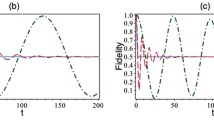Abstract
We investigate stochastic gravity as a potentially fruitful avenue for studying quantum effects in gravity. Following the approach of stochastic electrodynamics (sed), as a representation of the quantum gravity vacuum we construct a classical state of isotropic random gravitational radiation, expressed as a spin-2 field,h µυ (x), composed of plane waves of random phase on a flat spacetime manifold. Requiring Lorentz invariance leads to the result that the spectral composition function of the gravitational radiation,h(ω), must be proportional to 1/ω 2. The proportionality constant is determined by the Planck condition that the energy density consist ofħω/2 per normal mode, and this condition sets the amplitude scale of the random gravitational radiation at the order of the Planck length, giving a spectral composition functionh(ω) =√16πc 2Lp/ω2. As an application of stochastic gravity, we investigate the Davies-Unruh effect. We calculate the two-point correlation function (R iojo(Oτ−δτ/2)R kolo(O,τ+δτ/2)) of the measureable geodesic deviation tensor field,R iojo, for two situations: (i) at a point detector uniformly accelerating through the random gravitational radiation, and (ii) at an inertial detector in a heat bath of the random radiation at a finite temperature. We find that the two correlation functions agree to first order inaδτ/c provided that the temperature and acceleration satisfy the relationkT=ħa/2πc.
Similar content being viewed by others
References
Planck, M. (1911).Verh. Deutsch. Phys. Ges. 13, 138; (1912).Ann. Phys. (Leipzig) 37, 642.
Nernst, W. (1916).Verh. Deutsch. Phys. Ges. 18, 83.
Einstein, A., and Stern, O. (1913).Ann. Phys. (Leipzig) 40, 551.
Lamb, W. E., Jr., and Retherford, R. C. (1957).Phys. Rev. 72, 241; Lamb, W. E., Jr. (1951).Rep. Progr. Phys. 14, 19.
Louisell, W. H. (1964).Radiation and Noise in Quantum Electronics (McGraw-Hill, New York).
Casimir, H. B. K. (1948).Proc. Kon. Ned. Akad. Wet. 51, 793; Sparnaay, M. J. (1958).Physica (Utrecht) 24, 751; Derjaguin, B. V., Rabinovich, Y. I., and Churaev, N. V. (1979).Nature (London) 272, 313; Arnold, W., Hunklinger, S., and Dransfield, K. (1979).Phys. Rev. B 19, 6049.
Casimir, H. B. K., and Polder, D. (1948).Phys. Rev. 73, 360; Sukenkik, C. L., Boshier, M. G., Cho, D., Sandoghdar, V., and Hinds, E. A. (1993).Phys. Rev. Lett. 70, 560.
Gabrielse, G., and Dehmelt, H. (1985).Phys. Rev. Lett. 55, 67; Hulet, R. G., Hilfer, E. S., and Kleppner, D. (1985).Phys. Rev. Lett. 55, 2137; Jhe, W., Anderson, W. A., Hinds, E. A., Meschede, D., Moi, L., and Haroche, S. (1987).Phys. Rev. Lett. 58, 666; DeMartini, F., Innocenti, G., Jacobovitz, G. R., and Mataloni, P. (1987).Phys. Rev. Lett. 59, 2955; Goy, P., Raimond, J. M., Gross, M., and Haroche, S. (1983).Phys. Rev. Lett. 58, 1903; Heinzen, D. J., Childs, J. J., Thomas, J. F., and Feld, M. S. (1987).Phys. Rev. Lett. 58, 1320; Rempe, G., and Walther, H. (1987).Phys. Rev. Lett. 58, 353.
Davies, P. C. W. (1975).J. Phys. A 8, 609.
Unruh, W. G. (1976).Phys. Rev. D 14, 870.
Marshall, T. W. (1963).Proc. Roy. Soc. Lond. 276A, 475; (1965).Proc. Cambridge Phil. Soc. 61, 537.
Boyer, T. H. (1969).Phys. Rev. 182, 1374.
Marshall, T. W. (1963).Proc. Roy. Soc. Lond. 276A, 475; Boyer, T. H. (1973).Phys. Rev. A 7, 1832; (1980).Phys. Rev. A 21, 66; Milonni, P. W., Cook, R. J., and Goggin, M. E. (1988).Phys. Rev. A 38, 1621; Milonni, P. W. (1988).Physica Scripta T21, 102.
Milonni, P. W. (1976).Phys. Rep. 25, 1.
Haisch, B., Rueda, A., and Puthoff, H. E. (1994).Phys. Rev. A 49, 678.
de la Peña, L. (1983). InStochastic Processes Applied to Physics and other Related Fields, B. Gomez, S. M. Moore, A. M. Rodriguez-Vargas, and A. Rueda, eds. (World Scientific, Singapore).
Gross, D. J., Harvey, J. A., Martinec, E., and Rohm, R. (1985).Phys. Rev. Lett. 54, 502; Candelas, P., Horowitz, G. T., Strominger, A., and Witten, E. (1985).Nucl. Phys. B 258, 46; Witten, E. (1985).Phys. Lett. B155, 151; (1985).Nucl. Phys. B 258, 75.
DeWitt, B. S. (1967).Phys. Rev. 160, 1113;162, 1195;162, 1239.
Hawking, S. W. (1978).Phys. Rev. D 18, 1747.
Weinberg, S. (1965).Phys. Rev. B 138, 988.
Deser, S. (1970).Gen. Rel. Grav. 1, 9.
Boyer, T. H. (1980).Phys. Rev. D 21, 2137.
Misner, C. W., Thorne, K. S., and Wheeler, J. A. (1973).Gravitation (W. H. Freeman, San Francisco).
Bjorkin, J. D., and Drell, S. D. (1964).Relativistic Quantum Mechanics (McGraw-Hill, New York).
Hacyan, S., Sarimiento, A., Gocho, G., and Soto, F. (1985).Phys. Rev. D 32, 914.
Author information
Authors and Affiliations
Rights and permissions
About this article
Cite this article
Ross, D.K., Moreau, W. Stochastic gravity. Gen Relat Gravit 27, 845–858 (1995). https://doi.org/10.1007/BF02113067
Received:
Issue Date:
DOI: https://doi.org/10.1007/BF02113067




